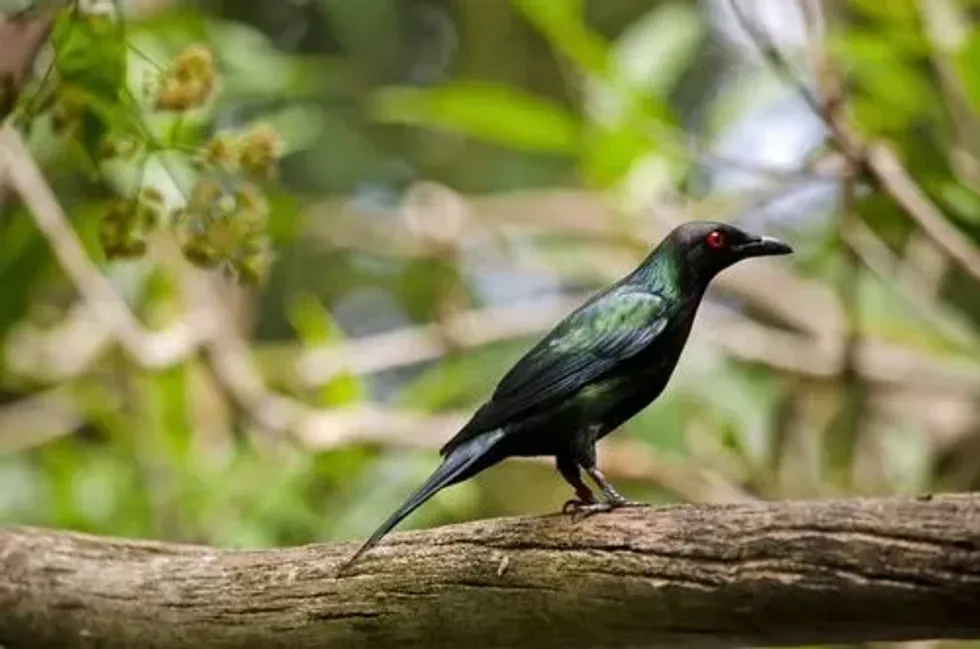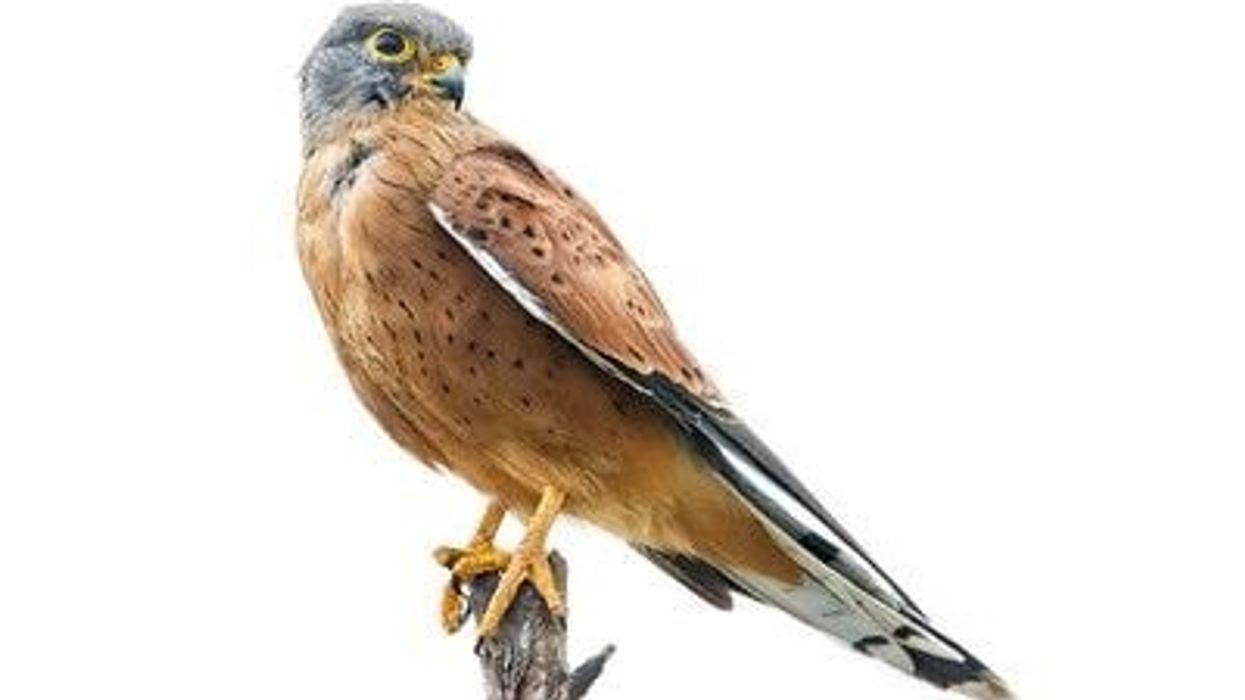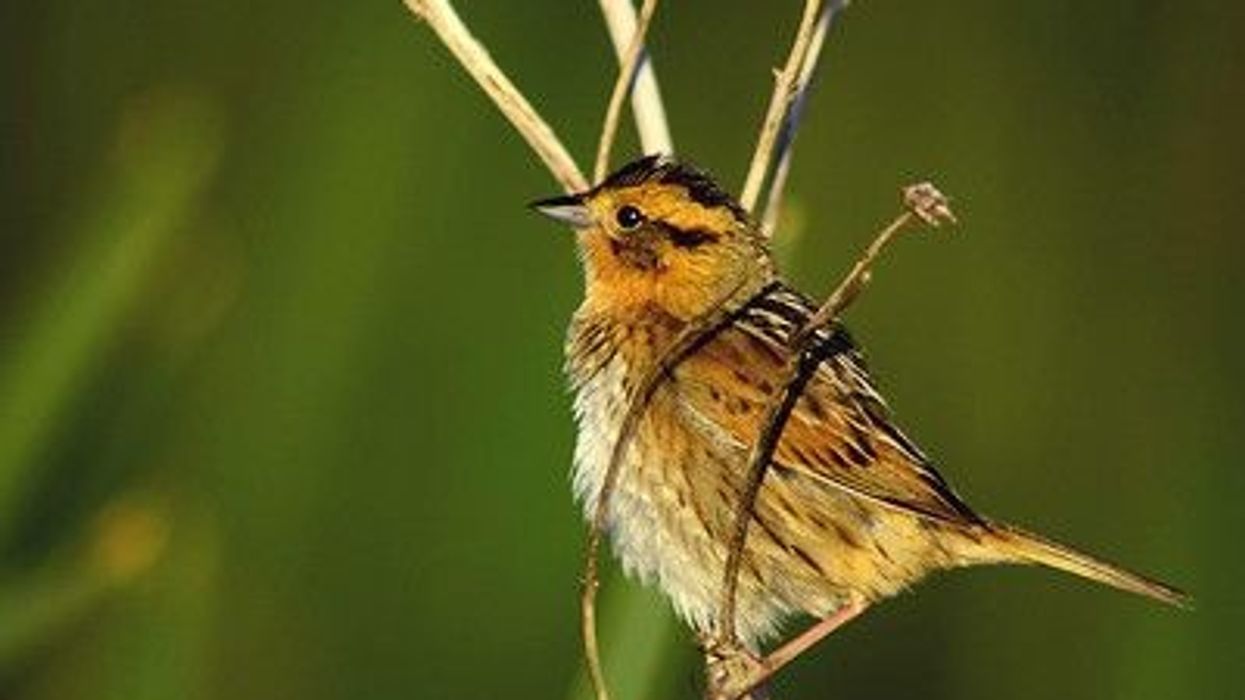The metallic starling is a member of the starling bird family. Also known as the shining starling, the metallic starling is native to the Solomon Islands, Queensland, New Guinea, and Moluccas.
They are known for being one of the most social starlings and their flocks are known for building globular nests that are messy and globular across their breeding habitats, such as rainforest and Australian coastal wetlands.
In terms of appearance, the starling (Aplonis metallica) metallic is a bird that has an all-black plumage along with dark streaks and red eyes. However, when they reflect the sunlight at a certain angle, they exhibit colorful arrays of green and purple iridescence.
Apart from their unique look, they are known for flying in large flocks and creating elaborate shapes and swirls in the sky.
These starlings aren't fearful of humans at all. However, if there is any disturbing human presence in their natural habitat, an adult calls out loudly to the flock, following which they are quick to enter a tight formation and fly away from potential danger.
When the danger clears, they fly back to their habitat together.
These birds live in large flocks as individuals have small sizes and generally can't fend off predators of a larger size on their own. However, in a flock, adults can look out for their family and deter potential predators from attacking them.
In this Kidadl fact file, we'll take you through the most interesting facts about metallic starlings. So, if you love birds, read on as we touch on different aspects of metallic starlings such as metallic starling wingspan and information about metallic starling hatchling along with the iconic metallic starling call.
For more facts-based articles right here on Kidadl, check out bower bird and budgerigar.
Metallic Starling Interesting Facts
What type of animal is a metallic starling?
Metallic starlings are birds, belonging to the Aves group.
What class of animal does a metallic starling belong to?
The metallic starling belongs to the class of animal known as birds, the family Sturnidae and genus Aplonis.
How many metallic starlings are there in the world?
The population of metallic starlings remains unknown as it has not been recorded.
Where does a metallic starling live?
Metallic starlings are incredibly flexible in terms of the habitats that they can adapt to. As a result, they thrive in a variety of Australian and non-Australian habitats such as rainforests, woodlands, and coastal wetlands. During the breeding season, they generally migrate northwards and are found in Queensland.
What is a metallic starling's habitat?
As mentioned before, the metallic starling can adapt to several habitats like the coastal wetlands, rainforests, and woodlands. However, they are native to regions such as Queensland, Moluccas, Solomon Islands and New Guinea.
They cover large distances during the migrations that they undertake during breeding season. When the dry season ends, they may migrate to far flung northern reaches of the world such as Queensland.
Who do metallic starlings live with?
Metallic starlings live in packs.
How long does a metallic starling live?
On average, metallic starlings live up to 15 years.
How do they reproduce?
In their natural habitats, metallic starlings reproduce during their breeding season, which typically begins in the month of August and lasts until the early days of spring. Starlings are known for building intricate nests by utilizing materials such as feathers, bark, and grass.
The nests look messy and globular and typically hang from tall trees. Reproduction takes place several times during the breeding season and after each gestation period, females typically lay 1 -3 eggs per clutch.
Through the whole breeding season, a female generally lays 5 - 7 eggs.
The juveniles stay in the nests built by their parents for 21-25 days, after which they leave for some time before returning for feeding. Once the breeding season is concluded, starlings return from the northern reaches to their natural habitats across the islands that surround Australia and New Guinea.
What is their conservation status?
The conservation status of metallic starlings is Least Concern. In their natural habitat, the metallic starlings play an important part in terms of being seed dispensers. They travel in mass colonies, which benefit a wide variety of tropical plants.
Metallic Starling Fun Facts
What do metallic starlings look like?
If you spot a metallic starling from a distance, it won't look anything out of the ordinary. However, if you wait for the sunlight to reflect off its body at a certain angle, you'll be left in awe when you spot the green and purple iridescence.
Without the reflection, both the male and female birds of this species appear all-black with short bills and red eyes. There are some differences in terms of appearance when it comes to juvenile metallic starlings and adult starlings.
For instance, juveniles bear white patches on their chests and shades of gray on their throats. However, these white and gray patches aren't present on the body of an adult.
The black plumage and red eyes are gradually developed as a juvenile matures into an adult. Juveniles also don't exhibit the green and purple iridescence the way that adults do.

How cute are they?
Metallic starlings are among the smallest birds and if you like birds in general, there's no reason why you shouldn't like them. They're also not naturally aggressive towards humans, which make them ideal to be kept as a pet.
How do they communicate?
These birds have earned quite a reputation for being one of the most expressive birds. The metallic starling across its native habitats in Australia and other regions makes a high-pitched sound during communication with others.
Their gregarious nature makes them communicate with each other throughout the day. Their nesting colonies located on tall trees are almost always noisy as these birds live together in large flocks.
How big is a metallic starling?
Compared to the length of the golden eagle (66 - 100 cm), a metallic starling is more than three times smaller.
How fast can a metallic starling fly?
In terms of flying speed, metallic starlings are similar to other starling species. The usual metallic starling flying speed is around 37 miles per hour (60 km per hour) while the peak speed is around 50 miles per hour (80 km per hour).
How much does a metallic starling weigh?
On average, a metallic starling weighs 57 grams or 0.12 pounds.
What are their male and female names of the species?
There are no gender-specific names for males and females of this bird species.
What would you call a baby metallic starling?
You would call a baby metallic starling a hatchling.
What do they eat?
In their natural habitats, metallic starlings are known for eating certain insects and types of fruit found in trees. In captivity, especially in zoos, their diet is typically omnivorous. While hatchlings are reliant on insects rich in proteins such as mealworms and crickets, adults need a combinations of fruit, bugs, and pellets.
Are they friendly?
The best answer to this question would be that metallic starlings aren't aggressive towards humans. However, they're not naturally friendly towards us. If you want to keep one as a pet, you'll have to give the bird some time and a lot of love and care before it warms up to you.
Would they make a good pet?
If you can give them the food that they need to survive, they can make for great pets. However, we'd recommend adopting one as a pet only if your location offers conditions that are prevalent on the islands surrounding Australia and New Guinea (tropical). These birds will struggle to adapt to cold environments.
Did you know...
During sunset, metallic starlings in their natural habitats prepare for their overnight roost in trees located near each other. Before they finally settle into their nests, they come together for quite a dazzling swirling display that looks choreographed as they take to the skies for a final loud chatter.
What is another name for a metallic starling?
Metallic starling is also known as Aplonis metallica (scientific name) or shining starling.
What are some differences between a Eurasian starling and the metallic starling?
Even though metallic starlings have plenty in common with starlings that are native to parts of the world other than Australia, they are slightly different. For example, compared to the Eurasian starling, the plumage of metallic starlings is quite different. The diet of the starling metallic is quite different too, as it consumes less insects than the Eurasian starling.
Here at Kidadl, we have carefully created lots of interesting family-friendly animal facts for everyone to discover! Learn more about some other birds including wren, or common loon.
You can even occupy yourself at home by drawing one on our Metallic Starling coloring pages.










